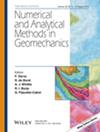Numerical Modelling of Frictional Sliding Induced Damage and Heating Effects on Rock With an Application to Sievers’ J‐Miniature Drilling on Granite
IF 3.4
2区 工程技术
Q2 ENGINEERING, GEOLOGICAL
International Journal for Numerical and Analytical Methods in Geomechanics
Pub Date : 2025-05-16
DOI:10.1002/nag.4005
引用次数: 0
Abstract
The present study develops a finite element‐based numerical method for simulation of frictional rotational sliding induced damage and heating effects on rock. The method is applied to the Sievers’ J‐ miniature drill test, which is widely used for estimating the rock drillability and predicting the cutter life. A continuum approach based on a damage‐viscoplastic model for rock failure is adopted. The viscoplasticity part, based on the Drucker–Prager yield surface with a rounded Rankine criterion as the tensile cut‐off, defines the stress states leading to rock failure. This failure is captured by the damage model, which uses separate damage variables for tension and compression (shear). A special workflow for generating granite mineral mesostructures based on Neper, DREAM3D, and Matlab software is developed. Moreover, nanoindentation tests are performed for determination of the elastic material constants for the Kuru granite constituent minerals. The global coupled thermo‐mechanical problem with frictional contact is solved with a staggered globally iterative approach. The FE discretized balance of linear momentum is time discretized with the Newmark scheme, and the FE discretized heat equation is time discretized with the Backward Euler scheme. The tangent stiffness operator required by the Newton–Raphson iteration is derived for the isothermal case using the penalty method for contact modelling. Preliminary numerical simulations of the Sievers’ J‐miniature drill test on granite demonstrate that the approach holds some promise and thereby provides a platform to be extended to simulate frictional rotational sliding induced damage and heating effects on rocks in other applications as well.岩石摩擦滑动损伤及加热效应数值模拟——以Sievers J -微型花岗岩钻井为例
本研究开发了一种基于有限元的数值模拟方法,用于模拟岩石摩擦旋转滑动引起的损伤和加热效应。该方法已应用于Sievers ' J -微型钻头试验,该试验广泛用于估计岩石可钻性和预测刀具寿命。采用基于损伤-粘塑性模型的连续介质方法研究岩石破坏。粘塑性部分以Drucker-Prager屈服面为基础,以圆形朗肯准则作为拉伸截止,定义导致岩石破坏的应力状态。这种破坏是由损伤模型捕获的,该模型使用单独的损伤变量进行拉伸和压缩(剪切)。开发了基于Neper、DREAM3D和Matlab软件的花岗岩矿物细观结构生成流程。此外,还进行了纳米压痕试验,以确定库鲁花岗岩组成矿物的弹性材料常数。采用交错全局迭代法求解了具有摩擦接触的全局热-力学耦合问题。用Newmark格式对线性动量的有限元离散平衡进行时间离散,用Backward Euler格式对热方程进行时间离散。在等温情况下,利用接触模型的惩罚法推导了牛顿-拉夫森迭代所需的切线刚度算子。Sievers在花岗岩上进行的J -微型钻头试验的初步数值模拟表明,该方法具有一定的前景,从而为在其他应用中模拟摩擦旋转滑动引起的岩石损伤和加热效应提供了一个平台。
本文章由计算机程序翻译,如有差异,请以英文原文为准。
求助全文
约1分钟内获得全文
求助全文
来源期刊
CiteScore
6.40
自引率
12.50%
发文量
160
审稿时长
9 months
期刊介绍:
The journal welcomes manuscripts that substantially contribute to the understanding of the complex mechanical behaviour of geomaterials (soils, rocks, concrete, ice, snow, and powders), through innovative experimental techniques, and/or through the development of novel numerical or hybrid experimental/numerical modelling concepts in geomechanics. Topics of interest include instabilities and localization, interface and surface phenomena, fracture and failure, multi-physics and other time-dependent phenomena, micromechanics and multi-scale methods, and inverse analysis and stochastic methods. Papers related to energy and environmental issues are particularly welcome. The illustration of the proposed methods and techniques to engineering problems is encouraged. However, manuscripts dealing with applications of existing methods, or proposing incremental improvements to existing methods – in particular marginal extensions of existing analytical solutions or numerical methods – will not be considered for review.

 求助内容:
求助内容: 应助结果提醒方式:
应助结果提醒方式:


